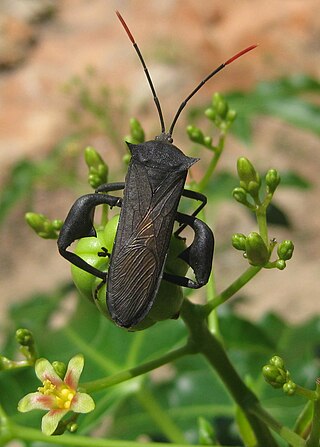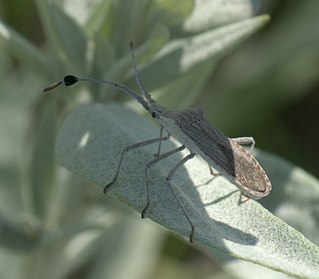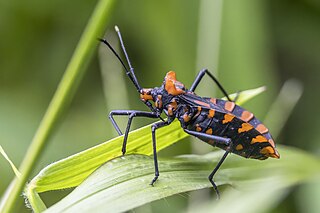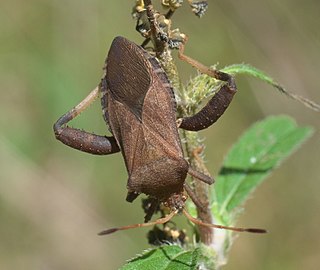
Coreidae is a large family of predominantly sap-sucking insects in the Hemipteran suborder Heteroptera. The name "Coreidae" derives from the genus Coreus, which derives from the Ancient Greek κόρις (kóris) meaning bedbug.

Anisoscelini is a tribe of leaf-footed bugs in the family Coreidae. It was formerly spelled Anisoscelidini, but the tribal name spelling was incorrectly formed.
Merocoris curtatus is a species of leaf-footed bug in the family Coreidae. It is found in North America.

Eubule is a genus of leaf-footed bugs in the family Coreidae. There are about 13 described species in Eubule.

Chariesterus is a genus of leaf-footed bugs in the family Coreidae. There are about 12 described species in Chariesterus.

Chariesterini is a tribe of leaf-footed bugs in the family Coreidae. There are at least 4 genera and more than 20 described species in Chariesterini.
Meropachyinae is a subfamily of leaf-footed bugs in the family Coreidae. There are at least 50 described species in Meropachyinae, recorded from the Americas.
Nisoscolopocerus is a genus of leaf-footed bugs in the family Coreidae. There are at least two described species in Nisoscolopocerus.

Ceraleptus is a genus of leaf-footed bugs, in the family Coreidae. There are about nine described species in Ceraleptus.

Scolopocerus is a genus of leaf-footed bugs in the family Coreidae. There are at least four described species in Scolopocerus.

Hypselonotus is a genus of leaf-footed bugs in the family Coreidae. There are about 12 described species in Hypselonotus.
Merocoris distinctus is a species of leaf-footed bug in the family Coreidae. It is found in Central America and North America.
Villasitocoris is a genus of leaf-footed bugs in the family Coreidae. There is one described species in Villasitocoris, V. inconspicuus.

Anisoscelis is a genus of leaf-footed bugs in the family Coreidae. There are about 11 described species in the genus Anisoscelis.
Acanthocerus is a genus of leaf-footed bugs in the family Coreidae. There are at least three described species in Acanthocerus.

Spartocera is a genus of leaf-footed bugs in the family Coreidae. There are about 18 described species in Spartocera.

Euthochtha is a genus of leaf-footed bugs in the family Coreidae, containing only one described species, E. galeator. It is sometimes referred to by the common name "helmeted squash bug".

Cimolus is a genus of leaf-footed bugs in the family Coreidae. There are at least four described species in Cimolus.
Mamurius is a genus of leaf-footed bugs in the family Coreidae. There are at least two described species in Mamurius.
Sethenira is a genus of leaf-footed bugs in the family Coreidae. There are about five described species in Sethenira.










